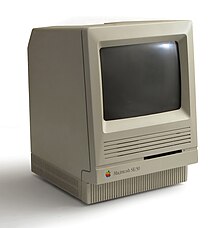Macintosh SE / 30
The Macintosh SE / 30 was an Apple computer model . It was introduced in January 1989 and was in the program until October 1991. Despite the very short production time, the SE / 30 sold well.
The Macintosh SE / 30 uses a Motorola 68030 with 16 MHz as processor and a Motorola 68882 as FPU coprocessor. The housing is based on that of the Macintosh SE with a built-in 9-inch screen (512 × 342 pixels, monochrome). The motherboard, however, was a new development and with eight 30-pin SIMM sockets for up to 128 Mbyte RAM and the processors mentioned, it offers considerable performance for the time being.
Interfaces to the outside world are SCSI (for external hard drives, CD-ROMs, scanners, printers, removable disk drives such as the SyQuest SQ555 , imagesetters and later also CD burners); also two serial interfaces (for modems, LocalTalk , serial Apple printers like the ImageWriter or StyleWriter ), ADB for input devices, an HD floppy disk drive and a headphone connection (8-bit, stereo, 22 kHz PCM, four-part). In mono, sounds can also be played via the built-in loudspeaker as an alternative.

The board of the SE / 30 is practically one of the Macintosh IIx , only without NuBus slots, but equipped with an SE / 30-PDS ( Processor Direct Slot ) for Ethernet cards, graphics cards, CPU cards, GPIB cards and the like. Because of its performance, the SE / 30 was very popular not least in the graphics industry, but also as a number cruncher in the scientific field because of the FPU . For this purpose it was often expanded with a color graphics card and equipped with monitors of up to 21 inches.
Mac OS systems from version 6.0.3 to 7.5.5 (with hacks also 8.1), A / UX 2.0 and 3.0.1, Minix , NetBSD and Linux run on the SE / 30 .
The successor to the SE / 30 is the Macintosh Classic II , which also has a Motorola 68030/16, but the bus bandwidth has been cut from 32 bits to 16 bits due to the memory connection and the address space for RAM is only 10 Mbytes.
See also: Macintosh models
